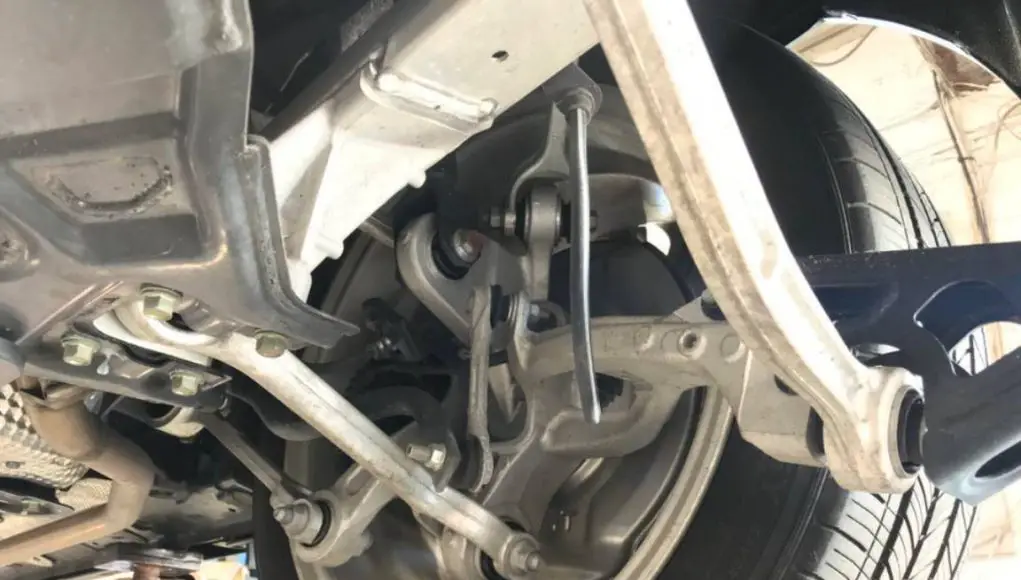A photo of the rear suspension setup of a 2018 Honda Clarity is breaking the greater car internet and here’s why.
It’s not often anyone gets a look at the rear suspension of any car so when this Redditor and technician took a peak underneath an uncommon new car, a 2018 Honda Clarity, he was shocked to see just how complicated, at first glance, the rear multi-link suspension looks like.
Check out a photo of the marvel of engineering that is the Honda Clarity rear suspension below.
This design looks rather complicated but in reality, it’s a lot easier to understand than you may think. A Redditor colored the relevant links and I’ve embedded that image below.
Furthermore, here’s a simplified look at the rear multi-link suspension from Honda’s press release.
First of all, multi-link suspenions have been around much longer than you think. Honda first introduced a 5 link multi-link suspension back in 1997, later incorporated in their other cars.
This is a quote from their press release 22-years ago.
“Honda’s innovative 5-link double wishbone suspension features for the first time in the world a Watt link arrangement. The five suspension arms are designed and laid out to provide optimum geometry under all driving situations, thus guaranteeing unprecedented handling and ride levels. A compact in-wheel layout was further adopted to increase cabin space and trunk volume.”
“Where a MacPherson strut setup only technically needs two controlling arms to keep it rigid, a multi-link needs a minimum of three lateral bars and one vertical(ish), or longitudinal. Each arm’s purpose is to limit and/or prevent the six degrees of an axle’s freedom; up and down, left and right and fore and aft. Sometimes some of the arms have ‘elbow’ joints along their length to achieve the necessary clearance around an axle while still achieving the proper angle of attack to fix to the hub.
So, if in reality, the Multi-link rear suspension looks rather uncomplicated when you begin to understand how all the links work, why did Reddit seemingly blow their collective minds over this Honda Clarity multi-link rear suspension set-up?
Packaging. Honda had to fit a large enough Hydrogen tank into the rear design of the Clarity, enough to give their Fuel Cell Vehicle decent range.
What they came up with was the smallest tank feasible, however large it is.
I can only assume Honda’s suspension engineers were then tasked with designing a multi-link rear suspension given such a small space. To give you an idea of just how much room they had, here are some schematics of the Clarity and tank.
There’s little space, indeed. Some bright minds managed to design a multi-link rear suspension in CAD in that tiny area between the tank and fender skirt that tucked neatly away yet managed to give all the ride comfort and handling they set out to deliver.
In Honda’s press release of the Clarity, Honda states
” Honda also adopted a rear suspension boasting high alignment rigidity, dual-pinion assist EPS creating an excellent steering feel, and a precision-control electric servo braking system. These elements combine to endow the Clarity Fuel Cell with direct handling and supple ride comparable to, or better than, a conventional premium sedan. “
” All of the arms of the rear multi-link suspension are forged aluminum instead of steel as on the previous model, to achieve a 40 percent weight reduction. The tie-rod, manufactured by the world’s first high-strength aluminum forging method , is 20 percent lighter than a conventional aluminum-forged type. “
Through clever engineering and packaging, Honda is able to deliver a Clarity that has both the handling and ride comfort of a premium sedan.
Keep in mind that the Clarity Fuel Cell Vehicle was designed first before Honda rolled out their Clarity EV only and Clarity Plug-in Hybrid. So, while this rear suspension might look bespoke to just the Fuel Cell Vehicle, rest assured it’s the same design in the Clarity EV and Plug-in Hybrid.
A pity that the only press the Honda Clarity fuel cell vehicle seems to get these days is the poor hydrogen infrastructure their FCV lessees have to operate in.
Honda’s multi-link rear suspension, while complicated looking, is a marvel of engineering that is just now getting the attention it deserves.
My hats off to you, Honda engineers, for working with what you got.




